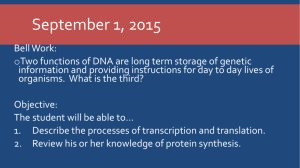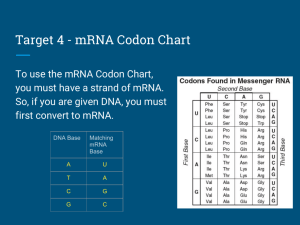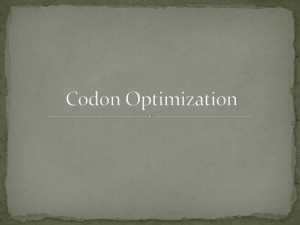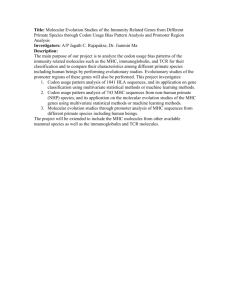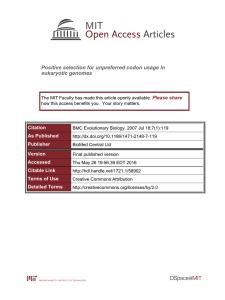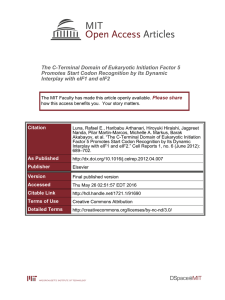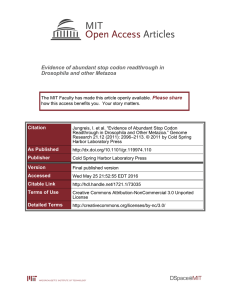SELECTIVE NEUTRALITY
advertisement
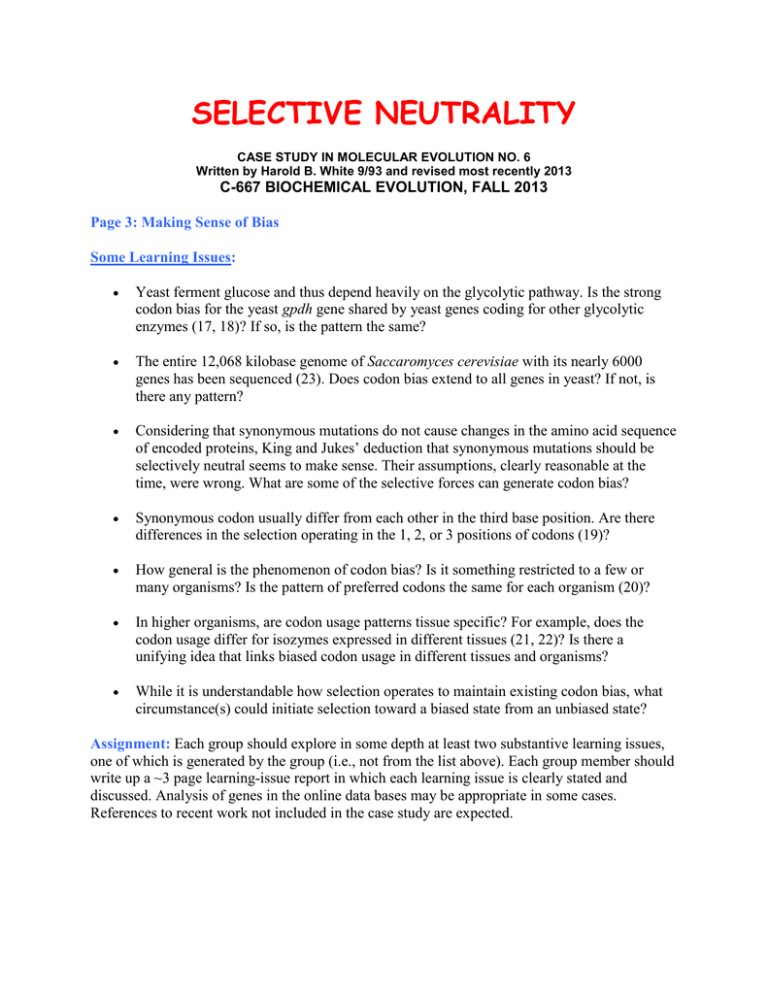
SELECTIVE NEUTRALITY CASE STUDY IN MOLECULAR EVOLUTION NO. 6 Written by Harold B. White 9/93 and revised most recently 2013 C-667 BIOCHEMICAL EVOLUTION, FALL 2013 Page 3: Making Sense of Bias Some Learning Issues: Yeast ferment glucose and thus depend heavily on the glycolytic pathway. Is the strong codon bias for the yeast gpdh gene shared by yeast genes coding for other glycolytic enzymes (17, 18)? If so, is the pattern the same? The entire 12,068 kilobase genome of Saccaromyces cerevisiae with its nearly 6000 genes has been sequenced (23). Does codon bias extend to all genes in yeast? If not, is there any pattern? Considering that synonymous mutations do not cause changes in the amino acid sequence of encoded proteins, King and Jukes’ deduction that synonymous mutations should be selectively neutral seems to make sense. Their assumptions, clearly reasonable at the time, were wrong. What are some of the selective forces can generate codon bias? Synonymous codon usually differ from each other in the third base position. Are there differences in the selection operating in the 1, 2, or 3 positions of codons (19)? How general is the phenomenon of codon bias? Is it something restricted to a few or many organisms? Is the pattern of preferred codons the same for each organism (20)? In higher organisms, are codon usage patterns tissue specific? For example, does the codon usage differ for isozymes expressed in different tissues (21, 22)? Is there a unifying idea that links biased codon usage in different tissues and organisms? While it is understandable how selection operates to maintain existing codon bias, what circumstance(s) could initiate selection toward a biased state from an unbiased state? Assignment: Each group should explore in some depth at least two substantive learning issues, one of which is generated by the group (i.e., not from the list above). Each group member should write up a ~3 page learning-issue report in which each learning issue is clearly stated and discussed. Analysis of genes in the online data bases may be appropriate in some cases. References to recent work not included in the case study are expected. References: 17. Bennetzen, J. L. and Hall, B. D. (1982) Codon selection in yeast, J. Biol. Chem. 257, 3026-3031. 18. Sharp, P. M., Tuohy, T.M.F. and Mosurski, K. (1986) Codon usage in yeast: cluster analysis clearly differentiates highly and lowly expressed genes, Nucleic Acids Res. 14, 5125-5143. 19. Miyata, T., Yasunaga, T. and Nishida, T. (1980) Nucleotide divergence and functional constraint in mRNA evolution, Proc. Natl. Acad. Sci. USA 77, 7328-7332. 20. Ikemura, T. (1985) Codon usage and tRNA content in unicellular and multicellular organisms, Mol. Biol. Evol. 2, 13-34. 21. Nakano, K., Hwang, P. K. and Fletterick, R. J. (1986) Complete cDNA sequence for rabbit muscle glycogen phosphorylase, FEBS Letters 204, 283-287. 22. Newgard, C. B., Nakano, K., Hwang, P. K. and Fletterick, R. J. (1986) Sequence analysis of the cDNA encoding human liver glycogen phosphorylase reveals tissue-specific codon usage, Proc. Natl. Acad. Sci. USA 83, 8132-8136. 23. Goffeau, A. et al. (15 other authors) (1996) Life with 6000 genes. Science, 274, 546 & 563 - 567.

